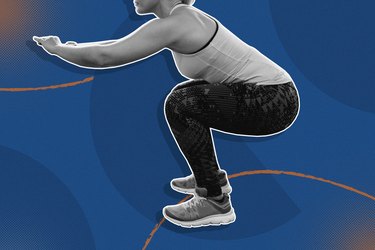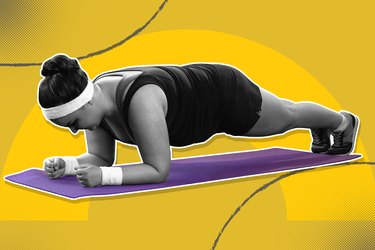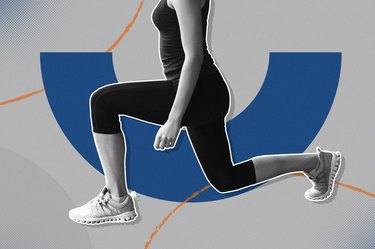
You might not realize it, but a squat is something you already do every single day. When you sit down and get up from a seated position, you are essentially doing a squat, explains Heather Fletcher, an exercise physiologist based in Tampa, Florida.
But squats aren't just great for performing basic everyday functions. The strength of your squat is also a reflection of your overall level of fitness.
Video of the Day
"Your legs contain some of the largest muscles in the body. [Doing squats] will help you build strength and improve muscle mass. You will recruit a high amount of energy and burn fat, and this will help you become stronger in your activities of daily life," Fletcher says.
But does it help or hurt to do squats daily? Here's what to expect if you take that route.
What Happens to Your Total-Body Strength
Squats are a compound movement, meaning they tap into multiple muscle groups across multiple joints.
In fact, Judine Saint Gerard, a certified personal trainer and fitness coach based in New York City, says they work the entire body. And doing them consistently — with correct form, of course, but more on that later — can help build everything from strength and power to balance and flexibility, she says.
The lower body bears the brunt of the motion, specifically your quads, which run along the front of the thigh, and all three muscles of your butt: the gluteus maximus, medius and minimus.
But other muscles in your legs — namely your hamstrings and hip flexors — are activated, Saint Gerard explains. And let's not forget about the stabilizing efforts of your core, which keeps your torso upright during the movement and reduces stress on your lower back.
While squats work different muscle groups at once, doing them every day doesn't necessarily mean that your upper body and core are getting the same TLC as your quads and glutes. So it's important to do workouts that focus on other muscles throughout the week.
Moreover, squats are "push" exercises because they involve the motion of pushing through your legs. Balancing them out with other lower-body and upper-body "pull" exercises, like deadlifts, rows, chest flyes and biceps curls, ensures that you're not neglecting other muscles.
What Happens to Your Mobility
As basic as the squat seems, this compound exercise comes with some challenges. For example, it takes a bit of mobility to perform a perfect squat. Things like tight ankles, stiff knees and locked-up hips (thanks to sitting) can limit your range of motion and make it difficult to really sink your butt back and down in a squat.
According to a March 2015 study in the Journal of Human Kinetics, limited range of motion in the hips, knees and ankles can affect your squat depth. By improving mobility and strength in the ankle and hip joints, you can improve your squat depth and prevent injuries related to squatting.
Not sure if mobility is the issue? Some tell-tale signs are leaning your torso forward, rounding your spine and/or lifting your toes off the ground while squatting. These breaks in form not only put you at risk for injury, but they also force your muscles to compensate in ways that make the exercise less effective.
But doing squats daily doesn't automatically make you better at them overnight. Taking a break from squatting every day to do ankle and mobility work (think: ankle circles and hip stretches) will ultimately help you get more out of this lower body-focused move.
What Happens to Your Progress
When you do the same squats every day, your muscles adapt to the movement. So while you may be able to maintain your gains, you won't continue to progress, Tim Brown, CPT, certified personal trainer and owner of the Factory Institute of Training, tells LIVESTRONG.com.
You'll know it's time to take your squats to new lows when they start becoming relatively easy to perform and you recover faster, Saint Gerard says.
"For example, I live in a walk-up, and when I first moved here, walking up these stairs had me out of breath," she says. "Within a month, I didn't have to think twice about climbing the stairs. Squats are similar; once they start feeling like you're on autopilot, it's time for a change."
To prevent hitting a plateau, it's important to practice progressive overload, which means you increase the volume, load and tempo/pace of your squats to make them more challenging. If you can complete 8 squats with proper form, try bumping it up to 12 reps, for example.
While body-weight squats are great for every fitness level, adding different types of squats to your workout routine provides other benefits, Brown says. "It is essential to use the different squat variations to see changes and target different areas of the leg muscles," Fletcher adds.
For example, a squat jump is a plyometric move that will spike your heart rate, adding an element of cardio to your squat routine. A squat pulse forces you to hold the bottom of your squat for a longer period of time, increasing the time your muscles are under tension.
If you're banging out 12 reps of the same squats like it's no big deal after three or four weeks of training, consider adding more weight and reps. Choose a new weight you can squat for 5 to 8 reps with proper form.
You can also make things more challenging by testing your unilateral (or single-leg) strength. Try doing weighted split squats to ensure one leg isn't stronger than the other. On that plyo train? Add a hop to your split squats.
What Happens to Your Bones
Once you're comfortable progressing to weighted squats, you have a chance to bring your upper body to the party and support strong bones.
According to Wolff's law, bones adapt to the stress put on them; increasing muscle tension with weighted squats (and other exercises) stimulates bone tissue to grow — and grow stronger. By adding some weight-bearing exercises to your routine — like barbell or dumbbell squats or goblet squats — you ultimately make your bones stronger. (Keep in mind that bone strength starts to decline as early as age 40, according to Harvard Health Publishing.)
Just beware that too much of a good thing can be bad if you're not careful. Inadequate recovery between your squat workouts, especially weighted ones, can lead to muscle fatigue instead of growth. Plus, exercising with sore muscles can make your workouts less effective.
How to Do a Proper Squat
Nailing your body-weight squat form is essential before you start trying out other variations, Brown says. And everyone's ideal squat form looks different.
"Someone with a very long femur bone — the bone that connects your hip to your knee (thigh bone) — like Lebron James may have a harder time getting into a deep squat than a shorter person like Simone Biles, who is anthropometrically gifted, for example," says Percell Dugger, a certified strength and conditioning coach and founder of GOODWRK.
In general, follow these pointers.
Body-Weight Squat Instructions
- Stand tall with your feet hip-width apart and brace your core. Focus on keeping your feet rooted into the ground and your core tight the entire time.
- Extend your arms out in front of you and slowly bend your knees as you push your hips back to lower toward the floor. Focus on lowering your body as if you were going to sit on a chair.
- Lower down as far as comfortable, or until your thighs are parallel with the floor.
- Pause for a moment at the bottom of your squat.
- On an exhale, reverse the motion by pressing through your heels to return to standing. As you stand, lower your arms back to your sides.
Tip
Your stance will largely depend on your mobility and the muscles worked. For example, a wider stance while squatting allows you to access your inner-thigh muscles a little more than standing with your feet hip-width apart.
“Make sure your knees don’t cave in or out at any point during the move,” Dugger says. He also notes to keep your core engaged throughout the movement.
Bottom Line: Squat Often, Recover Hard
Your muscle recovery determines how safe it is for you to do squats every day. "If you are only doing body-weight squats, the recovery is generally easy," Fletcher says.
But if you are doing something more challenging, like squat jumps, weighted squats or squat thrusters, your muscles might need a little more time to rest and repair. Don't skimp on recovery time; your muscles get stronger only when you allow them to repair.
Recovering correctly means following proper nutrition to replenish your energy stores and repair muscles, getting enough sleep and foam rolling (especially the quads and calves) or stretching to relieve sore, tight muscles, Saint Gerard says.
Saint Gerard recommends doing "all of the things you would need so your body can be like, 'alright, let's do it again at the same intensity with the same quality,'" she says.
The American Council on Exercise recommends 48 to 72 hours of recovery between strength and power workouts. (You can schedule cardio or other active recovery workouts on those days.) If you don't recover fully, you risk losing gains from your workouts — and compromising the integrity of the exercise during your next session.
"Your body is going to start compensating," Saint Gerard says. "All the muscles that come in to help — you are going to start feeling those more. If your quads are toast, for instance, you might start to feel it more in your lower back or upper back, if you are barbell squatting."
Ultimately, squatting every day isn't necessarily a bad thing, and the risk of overuse injuries is low. However, you want to make sure you're working other muscle groups, too. Focusing solely on your lower body can set you up for muscle imbalances — and nobody wants that.
- Journal of Human Kinetics: "Lower Extremity Strength and the Range of Motion in Relation to Squat Depth"
- Harvard Health: "Slowing Bone Loss With Weight-Bearing Exercise"
- American Council on Exercise: "How to Select the Right Rest Intervals and Post-Training Recovery for Your Clients"
- Oxford Reference: "Wolff's Law"
- Lower Extremity Strength and the Range of Motion in Relation to Squat Depth
- Slowing bone loss with weight-bearing exerciseSlowing bone loss with weight-bearing exercise



